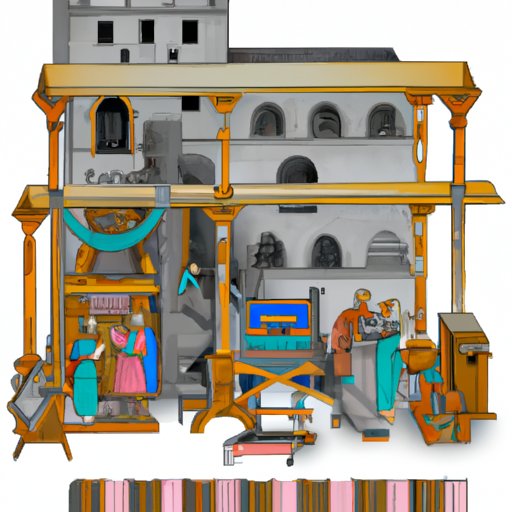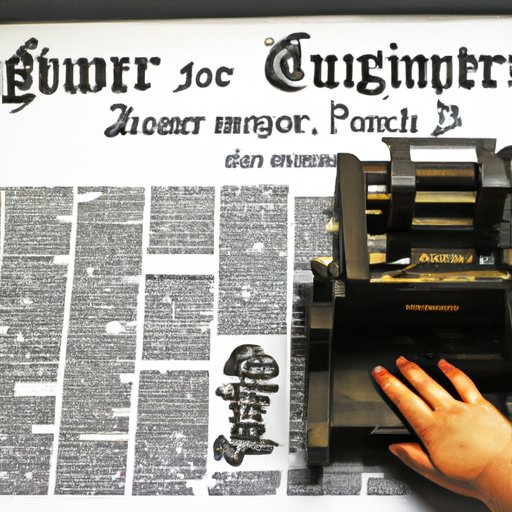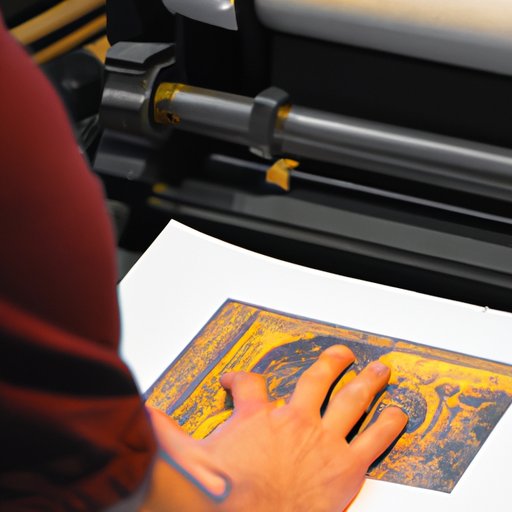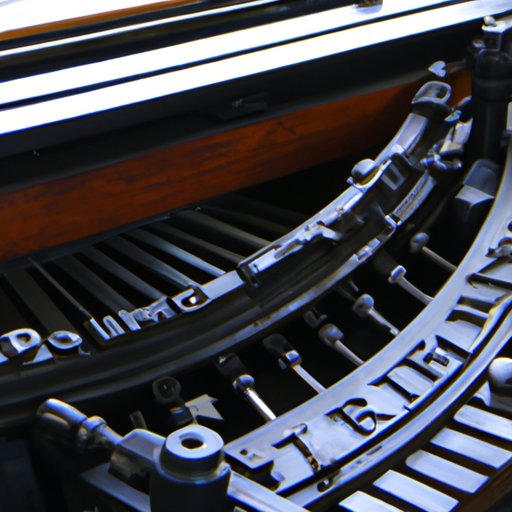Introduction
The invention of the printing press is one of the most important events in human history. This revolutionary technology changed the way knowledge was shared and disseminated, impacting culture, commerce, and education around the world. The invention of the printing press during the Renaissance period was particularly influential, as it marked a new era of innovation and discovery.
In this article, we will explore the invention of the printing press during the Renaissance period. We will examine the historical context in which the printing press was invented, analyze how it revolutionized the Renaissance, investigate its impact on society, and consider the role of Johannes Gutenberg in developing the technology.
Definition of the Printing Press
A printing press is a mechanical device used to print multiple copies of a text or image onto a sheet of paper. It works by pressing an inked surface against a piece of paper, transferring the ink from the surface to the paper. The first printing presses were developed in the mid-15th century, and they quickly spread throughout Europe and beyond.

Overview of the Renaissance Period
The Renaissance was a period of great cultural and intellectual advancement in Europe. It began in Italy in the 14th century and spread to other parts of Europe by the 16th century. During this time, there was a renewed interest in art, literature, philosophy, science, and technology. Innovations such as the printing press helped to shape the European Renaissance and usher in a new era of exploration and discovery.

Historical Overview of the Invention of the Printing Press During the Renaissance
The printing press was invented during the Renaissance period, and it had a profound impact on the cultural and intellectual life of the time. Let’s take a look at how the printing press came to be and how it changed the course of history.
Gutenberg’s Role in Developing the Printing Press
The printing press was invented by Johannes Gutenberg, a German goldsmith and printer, in the mid-15th century. Gutenberg developed a movable type system, which allowed him to easily create multiple copies of a text or image. He also improved upon existing printing technologies, making his printing press faster and more efficient than ever before.
Impact on Trade and Commerce
The invention of the printing press had a major impact on trade and commerce in Europe. It enabled merchants to quickly and easily produce large amounts of printed materials, such as pamphlets, books, and other documents. This made it easier for merchants to advertise their goods and services, and it also enabled them to keep better records of their transactions.
An Analysis of How the Printing Press Revolutionized the Renaissance
The invention of the printing press revolutionized the Renaissance period in many ways. Let’s take a closer look at some of the most significant changes it brought about.
Increased Access to Information
One of the most significant impacts of the printing press was that it made information more accessible. Before the printing press, books and manuscripts were laboriously copied by hand, which limited their availability. But with the printing press, books could be quickly and cheaply produced, making them much more widely available. This increased access to information had a profound impact on the cultural and intellectual life of the time.
Changes in Printing Technology
The invention of the printing press also led to advances in printing technology. Gutenberg’s movable type system was a major breakthrough, as it allowed for the rapid production of printed materials. This paved the way for further innovations in printing technology, such as lithography and offset printing. These advances enabled printers to produce larger quantities of printed material in less time, making them more affordable and accessible.
Impact on Education and Learning
The invention of the printing press also had a major impact on education and learning. With the increased availability of printed materials, more people had access to knowledge, which led to an increase in literacy rates. This in turn enabled more people to pursue higher education, leading to the emergence of a new class of intellectuals who could contribute to the cultural and intellectual life of the time.
Exploring the Impact of the Printing Press on Renaissance Society
The invention of the printing press had a far-reaching impact on Renaissance society. Here are some of the most significant changes it brought about.
Increase in Literacy Rates
The increased availability of printed materials had a major impact on literacy rates. With more books and other printed materials available, more people had access to knowledge, which led to an increase in literacy rates. According to a study published in the journal Science, “the introduction of the printing press increased literacy rates by almost 50%.”
Expansion of Publishing Industry
The invention of the printing press also led to the expansion of the publishing industry. With the ability to quickly and cheaply produce large quantities of printed material, publishers were able to reach a wider audience. This led to a surge in the number of books being published, as well as an increase in the variety of books available.
Influence on Art, Literature, and Philosophy
The printing press also had a major influence on the art, literature, and philosophy of the Renaissance period. With the increased availability of printed materials, writers and thinkers were able to share their ideas with a wider audience, leading to a flourishing of creative expression. The printing press also enabled the spread of new ideas and schools of thought, which had a major impact on the cultural and intellectual life of the time.

Examining the Role of Gutenberg in Developing the Printing Press During the Renaissance
Johannes Gutenberg played a major role in developing the printing press during the Renaissance period. Let’s take a closer look at his contributions.
His Contributions to Printing Technology
Gutenberg was instrumental in developing the printing press. His movable type system enabled him to quickly and easily produce multiple copies of a text or image. He also improved upon existing printing technologies, making his printing press faster and more efficient than ever before. His innovations laid the foundation for modern printing technology, and his contributions are still felt today.
His Impact on the Cultural Climate of the Time
Gutenberg’s invention of the printing press also had a major impact on the cultural climate of the time. His invention enabled the spread of knowledge and ideas, which had a profound effect on the art, literature, and philosophy of the Renaissance period. Gutenberg’s invention of the printing press was an important milestone in the development of modern society.

Investigating the Cultural and Intellectual Changes Brought About by the Printing Press During the Renaissance
The invention of the printing press had a major impact on the cultural and intellectual life of the Renaissance period. Let’s take a closer look at some of the changes it brought about.
Development of New Ideas and Schools of Thought
The increased availability of printed materials enabled the spread of new ideas and schools of thought. Writers and thinkers were able to share their ideas with a wider audience, leading to a flourishing of creative expression. This had a major impact on the art, literature, and philosophy of the time.
Emergence of a New Class of Intellectuals
The invention of the printing press also led to the emergence of a new class of intellectuals. With the increased availability of printed materials, more people had access to knowledge, which led to an increase in literacy rates. This in turn enabled more people to pursue higher education, leading to the emergence of a new class of intellectuals who could contribute to the cultural and intellectual life of the time.
Impact on Religion and Politics
The invention of the printing press also had a major impact on religion and politics. Printed materials such as pamphlets and books enabled religious and political leaders to spread their ideas to a wider audience. This had a major impact on the spiritual and political landscape of the time, leading to the rise of new religious and political movements.
Conclusion
The invention of the printing press during the Renaissance period was a major turning point in human history. It revolutionized the way knowledge was shared and disseminated, impacting culture, commerce, and education around the world. The invention of the printing press enabled the spread of new ideas and schools of thought, increased literacy rates, and shaped religious and political thought. The legacy of the printing press continues to this day, and its impact on the cultural and intellectual life of the Renaissance period cannot be overstated.
(Note: Is this article not meeting your expectations? Do you have knowledge or insights to share? Unlock new opportunities and expand your reach by joining our authors team. Click Registration to join us and share your expertise with our readers.)
